What Type of Actuator Switch Do I Need?
There are lots of types of electrical switches out there, so how do you know which one is best for controlling a linear actuator. As you are most likely wanting to extend and retract your linear actuator, you’ll want to use a Double Pole Double Throw (DPDT) ON-OFF-ON switch. The number of poles and throws a Linear Actuator switch has will define how it operates and refers to the number of circuits and number of on positions, respectively. A double pole Actuator switch will allow you to change the direction of the input voltage to the actuator, which is needed to change directions, while a double throw gives you two ON positions, one for extension and the other for retraction. You can also find DPDT switches that are ON-ON, which means there is no off position, but these Actuator switches might not make sense for controlling an actuator in your application.

Even still, there are lots of DPDT ON-OFF-ON switches out there in various styles and with different features. Your choice between these different Actuator switches will mostly depend on your application or personal preference, but there is one feature that will impact how the Actuator switch will operate, which is whether the Actuator switch is momentary or non-momentary. Momentary switches will always default to the center position if not pressed, while non-momentary or sustaining switches, will lock into the last position it was pressed to. Both of these types of actuator switches are able to be used to control a linear actuator and the one you choose will depend on your application and preference, but it is important to consider as it may make more sense to use one style over the other for your situation.
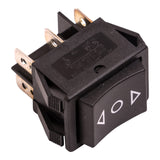

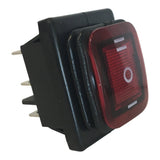
Once you know how you want your 12v Actuator switch to function, you can start looking at the different styles and features of the various switches; including rocker switches, toggle switches, and LED backlighted switches. But before you purchase, you’ll want to check out the specifications of your desired Actuator switch. These specifications include size, electrical properties, and life expectancy, but the most important, for most applications, is the power rating. The power rating is usually given as an amperage and voltage in either AC or DC, as an example: 16A 250V AC, and is the absolute power limit your switch can handle. If your Actuator switch is only rated for AC, it can still be used with a DC circuit, but the power rating will be much reduced (around 10% of the AC rating, but that’s not a hard rule). This is particularly important when using Actuator switches with inductive loads, like a linear actuator, as turning on the switch causes an inrush of current and turning off causes a peak in voltage. These high points in current and voltage may surpass the rated values of your switch, which will shorten the life of the actuator switch or even cause it to fail immediately [1]. Because of this, it is important to ensure your selected Actuator switch has a higher power rating than you need.
Controlling a Linear Actuator with a Actuator Switch
Once you have selected a Actuator switch that works within your application, the setup to control the linear actuator is fairly straight forward. On the bottom of your switch you will see 6 connectors, as seen below, that will line up with the circuit diagram of the DPDT switch above. If the switch is pressed to the forward position, the top and middle connectors will be connected inside the switch; if the switch is pressed to the back position, the bottom and middle connectors will be connected; and if the switch is in the middle position, the switch is open.
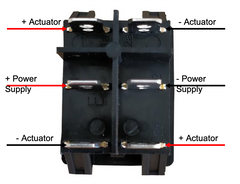
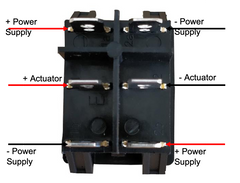
As seen above, you can hook up your 12v actuator switch in two ways to control your linear actuator. The first is to connect the actuator to both the top and bottom connectors with the positive and negative leads switching sides and having the power supply connected to the middle connectors, as seen on the left above. The other way is to do the opposite, having the power supply connected to both the top and bottom connectors with the positive and negative leads switching sides and having the actuator connected to the middle connectors, as seen on the right. Functionally, these two wirings do the same thing. As the outside connectors flip sides on either end, the polarity to the actuator is flipped and causes the direction of motion to change.
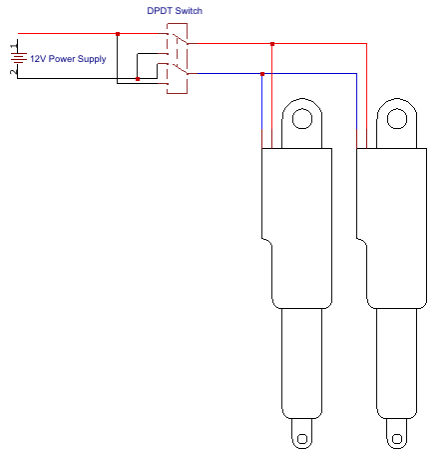
Your choice in setup will depend on your application and preference. This setup can also be used to control more than one actuator at the same time by connecting the actuators in parallel, as seen above. You will need to be careful when doing this as more actuators connected in parallel will increase the total current draw. You’ll need to ensure your actuator switch can handle the increase in current draw as mentioned in the previous section of this blog.
Overcoming Power Limitations
As mentioned above, you’ll need to be careful that you do not exceed the power rating of your Actuator switch, but what if you cannot find an Actuator switch that meets your requirements. That’s when relays come into play. Relays are electromagnetic switch that can be operated by a smaller current to turn on and off a much larger current [2]. Relays allow you to use a smaller switch to control a larger electrical load without concerns of exceeding the power rating of your switch because the two circuits are physically isolated. Relays are switches, so they use similar terminology, and they work by having a coil, that becomes magnetic when energized, to open and close the connection of the high powered circuit [2]. The connection that is made when the coil is not energized is called normally close (NC) and the connection that is made when the coil is energized is called normally open (NO). Relays also have power ratings that you’ll need to inspect to ensure they will work within your design.
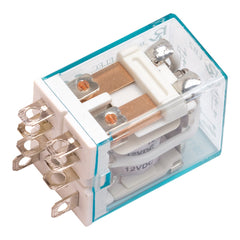
To control a linear actuator, you need to use either a DPDT relay with a SPST (single pole single throw) switch or two SPDT (single pole double throw) relays with a DPDT switch. Utilizing the single DPDT relay configuration, as seen below on the left, you only need a SPST switch because there is only one coil to energize. When the coil is energized, the actuator will extend and when the coil is not energized, the actuator will retract. This means there is no off position, which may not be acceptable for your design. If you need your actuator to stop in between the fully extended and fully retracted positions, you’ll want to make use of the two SPDT relays with a DPDT ON-OFF-ON switch configuration. In this configuration, shown below on the right, the two relays are used to flip the polarity of the voltage to the actuator and the switch is used to control the relays. You’ll need to setup your circuit to ensure when neither coil is energized there is no power connected to the actuator (both leads of the actuator is connected to ground) when the switch is in the off position. When the Actuator switch is pressed forward, only one coil gets energized to cause the actuator to extend and when the Actuator switch is pressed backwards, the opposite coil is energized to cause the actuator to retract.
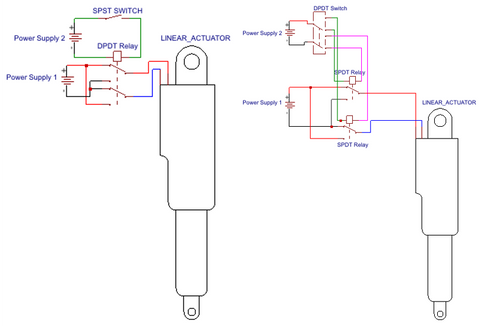
While utilizing relays causes the setup to control your linear actuator to be more complicated, it allows you to safely control higher power loads without concerns of your linear actuator switch failing. This is key when you are moving heavy loads with your linear actuator or you plan to control multiple linear actuators with a single switch.
Limitations
There are a few limitations when controlling a linear actuator with a linear actuator switch. Firstly, you will be unable to control multiple actuators at different times. If you want to control two actuators separately, you’ll need to make use of two switches to do so. You will also be unable to adjust the speed of your linear actuator; you will only have control over the direction your actuator travels in. Another limitation is the inability to utilize feedback from your actuator, which could be used for more precise positioning of the actuator.
While there are some limitations, they may not be significant in your application and in that case makes controlling a linear actuator with a switch an easy and simple solution. If you do need more control, you’ll need to make use of a more complex control system.
- Ramos, R. (2018, November). Choosing the Right Switch: Know Your AC from Your DC. Retrieved From: https://www.electronicdesign.com/technologies/analog/article/21807286/choosing-the-right-switch-know-your-ac-from-your-dc
- Woodford, C. (2019, June). Relays. Retrieved From: https://www.explainthatstuff.com/howrelayswork.html
